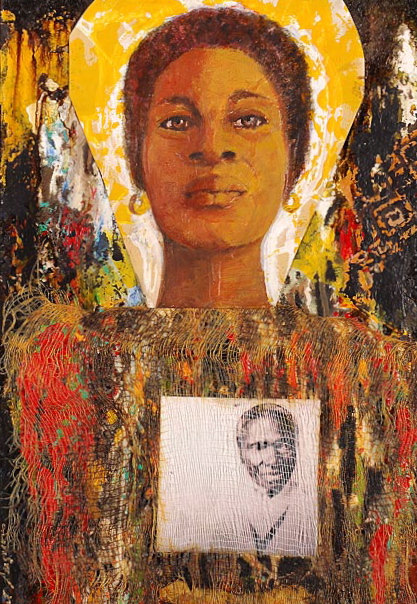This Odyssey is part of a series of paintings. The series depicts the
problematic but essential aspects of remembering and
reconstructing the history of the African American experience
and dealing with the fragmentary nature of that experience – a piece
here, a piece there, a memory here, a memory there.
Sojourner Truth was born Isabella (Bell) Baumfree. She was born in
1797, and she died on November 26, 1883. She was an African American
abolitionist and woman rights activist. She was born into slavery
in Swantekill, Ulster County, N.Y. She escaped with her infant daughter
to freedom in 1826. After going to court to regain her son in 1828, she
was the first black woman to win her case in a white court.
She named herself Sojourner Truth in 1843. She is known for her
speech,“Ain’t I a Woman,” which she gave at an Ohio Woman’s
Rights convention in Akron, Oh. The speech became well known
during the Civil War. It was translated using a stereotypical
Southern dialect, although Sojourner grew up in New York and
spoke Dutch as her first language.
During the Civil War, she assisted in recruiting Black troops for the
Union Army. After the war, she unsuccessfully tried to secure land
grants for former slaves from the Federal Government.
How did I come to make this a Sojourner Truth painting? Serendipity.
I was surfing the net one day, looking for inspiration and for some reason
her name kept showing up. Yielding to the universe, I decide to look her
up and read her story on Wikipedia (yeah, I know – not the best place but it
comes up first). I was so impressed, I felt a calling that the painting had to be
in memory of Sojourner. As I mentioned earlier in this blog, I was not looking
for her. It turns out she was looking for me like much of history.
As the painting evolved, the woman in the painting had to have a
light around her head representing courage, enlightenment, and
strength. I wanted the feeling of looking to the future, dismissing
fear and obtaining justice whatever the results. Although the woman
in the painting is of African American descent, it could still be any woman.
It is amazing how some want to de-universalize black images. I see the energy
in the piece and think that it could apply to the broadest of audiences.
I thank Sojourner for her courage and inspiration. I thank her for finding me
and reminding me of that.
problematic but essential aspects of remembering and
reconstructing the history of the African American experience
and dealing with the fragmentary nature of that experience – a piece
here, a piece there, a memory here, a memory there.
Sojourner Truth was born Isabella (Bell) Baumfree. She was born in
1797, and she died on November 26, 1883. She was an African American
abolitionist and woman rights activist. She was born into slavery
in Swantekill, Ulster County, N.Y. She escaped with her infant daughter
to freedom in 1826. After going to court to regain her son in 1828, she
was the first black woman to win her case in a white court.
She named herself Sojourner Truth in 1843. She is known for her
speech,“Ain’t I a Woman,” which she gave at an Ohio Woman’s
Rights convention in Akron, Oh. The speech became well known
during the Civil War. It was translated using a stereotypical
Southern dialect, although Sojourner grew up in New York and
spoke Dutch as her first language.
During the Civil War, she assisted in recruiting Black troops for the
Union Army. After the war, she unsuccessfully tried to secure land
grants for former slaves from the Federal Government.
How did I come to make this a Sojourner Truth painting? Serendipity.
I was surfing the net one day, looking for inspiration and for some reason
her name kept showing up. Yielding to the universe, I decide to look her
up and read her story on Wikipedia (yeah, I know – not the best place but it
comes up first). I was so impressed, I felt a calling that the painting had to be
in memory of Sojourner. As I mentioned earlier in this blog, I was not looking
for her. It turns out she was looking for me like much of history.
As the painting evolved, the woman in the painting had to have a
light around her head representing courage, enlightenment, and
strength. I wanted the feeling of looking to the future, dismissing
fear and obtaining justice whatever the results. Although the woman
in the painting is of African American descent, it could still be any woman.
It is amazing how some want to de-universalize black images. I see the energy
in the piece and think that it could apply to the broadest of audiences.
I thank Sojourner for her courage and inspiration. I thank her for finding me
and reminding me of that.

 RSS Feed
RSS Feed